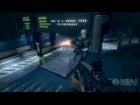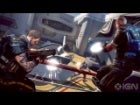Paul Wedgewood: Everybody has that skill, it's just that they're taught to play a first-person shooter a certain way, which is like Time Crisis. That kind of notion can be really good fun, but you're basically on a mine car, watching canned cinematics and stuff. [Brink] is a true single-player narrative-driven game with significant objectives and everything, but you can still make these multiple tactical choices at any point. So you end up playing a combat role that you really enjoy playing, going to roots and doing the things that you like.
If you love the free-running elements of the game, you could have a skinny character who's got really good agility. If you prefer the soldiering stuff, you can beef up your character and take a ton more damage and follow the more direct route. So it ends up giving you an experience which, if you don't have an Internet connection, is nevertheless a really compelling shooter.
But the minute you plug your console in... we're like, come on, try it, try it, and we turn off voice over IP, so none of those 13-year-old racists are gonna [ruin your experience]. Because it's always like, even in Wolfenstein: Enemy Territory, people would get home and they'd download it and try to run it and it'd say, you haven't got a good enough 3D graphics card. So they go down to the game store, buy a 3D graphics card, plug it in, and now they find out that they don't have broadband, they just have a modem. They finally upgrade that, they get online, and they need a patch. They get the game patched and figure all that stuff out and they finally get to a server and a 13-year-old headshots them five times, teabags them five times in a row, and swears at them profusely. That's the trial by fire. If you have a thick enough skin that you survive that, you end up being into multiplayer shooters.

On How Brink Brings New People to Multiplayer
Paul Wedgewood: What we want to try and do is just play on that cooperative bridge, which is much more convivial, where you're playing against AI, where it's less offensive to get your ass kicked by a computer. And use that as a method of bringing you into playing alongside other people. Then what's good about the dynamic mission system is [it gives you] that buzz you always had in '97, '98, and '99, where we'd work out all our plays on IRC and go online and kick the crap out of some clan because...coordinating as a team is amazing. How do you get strangers to start experiencing that? It's obvious now, in hindsight, now that we've got it working, but obviously what you need is a dynamic squad commander who can analyze everything that's going on on the battlefield and give everybody a bunch of cool tasks to get done.On Custom Character Design in Brink and its Potential
Paul Wedgewood: You create your guy how you want him to be. You start out in the game and you choose your ethnicity, the kind of archetype you want to be presented as, things like facial hair. But we go a bit crazier than, say, your average sports game. We have scarification, where you staple your own face together, and all these mad things. Tattoos and stuff. Then you start out with your basic combat outfit. You're like a recruit in the resistance or the security. As you play through the game, on the side that you've chosen, you start to unlock these cool outfits and upgrades that get better and better. You can customize and combine all those different components. We end up having something like 19.2 billion combinations. Now of course they're not all truly unique, you can't count all the colors of hair as being unique versions of the same guy, but it's enough that when you get online with 16 people or whatever, it's very unlikely that anyone's going to look exactly like you when you're playing together.
The potential, then, for clan colors and all that stuff is brilliant. It's so cool. But it also means that each step as you play through the game is continuously rewarding, because you always feel like your character, the skill that you're developing as a shooter player, is reflected in the way that your character looks. We've learned from people like Bethesda Softworks, who really inspired us towards the end of '07 when we were looking at their work with Morrowind and Oblivion. Those role-playing elements, it was like...we always thought, why do we have to play this genre to get this feature, and then we have to go to this other one, why can't we just do all of it in one game? That sounds like a 15-year-old's game design, but we just did it anyway I guess.

On Why Your Character Isn't the "Hero" of Brink
Paul Wedgewood: The thing is, it evolves into a multiplayer game, we hope, for the large majority of players. It would be silly and contrived to give you the impression that you were the star of the entire game. For the same reason, you just might not like being the one who has to play touchdown, running up and putting down the explosive charge over and over, trying to get that done. There's no point in trying to convince somebody that what we want them to do is what they want to do. The idea is to have a good rule set.
When you're kids and you play in a sandbox with your toys and things, you get out your truck and you get out your plane and you play with them and get bored and that's it, you're done. But some of us, I think predominantly gamers, when we get into our early teens, we sit with our mates and we think, what if we make rules, like we can only move forward one space at a time each? Suddenly that tank or that truck or whatever, you can play with it for hours and hours... because you applied the simplest of basic rules to something that you were otherwise completely bored with. Then you get into your late teens, you set fire to them all, but that's the general thing.





